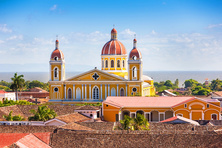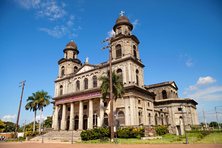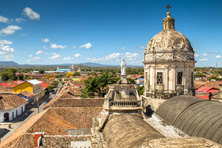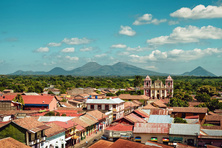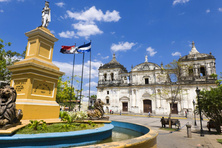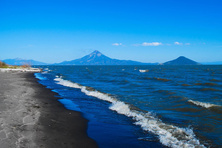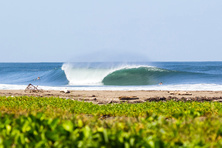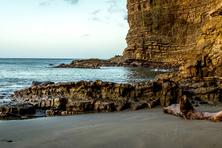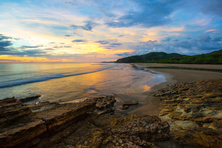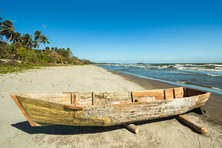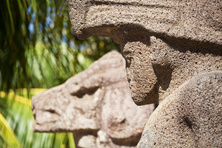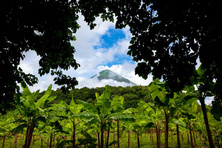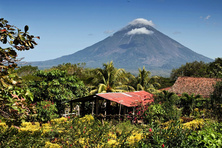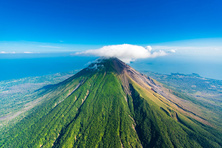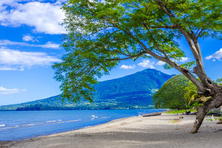Nicaragua
- Currency: cordoba
- Time: UTC-6
- Languages: Spanish
- Religions: Christianity (Catholicism, Protestantism)
- Sections: Get in Visa Customs Cuisine Money Details of interest Popular resorts
Nicaragua is a state in Central America. It shares its borders with Honduras and Costa Rica. Nicaragua is washed by the Pacific and Caribbean Seas. The capital city is Managua.
The climate in the country is tropical with trade winds. The average winter temperature is from +16 °C to +20 °C. Tropical cyclones are typical for Nicaragua. We recommend traveling to Nicaragua from December to April.
The majority of the population are the Catholics and Protestants. The official language is Spanish.
Those who love to relax on the beach should go to the sea resorts in the Tiscapa Lagoon. The Pacific coast is ideal for surfing. The divers usually meet at San Juan del Sur. Resorts on the Corn islands are gaining popularity these days.
If you search good city entertainments, shopping and sightseeing, head to Granada. In this city, everyone can sense the history of the country visiting such places as San Fransisco Convent, Guadalupe Church, Plaza de la Polvora, Xalteva Church and Cathedral of Granada. In the city of Masaya, there is the largest National Artisan Market. In Ometepe, one can visit the Numismatic Museum. We also recommend visiting the village Moyogalpa on the Ometepe Island. Leon is a cultural and touristic center with the largest cathedral in Central America.
Escape the city noise in the Nicaraguan reserves and natural parks. One will be greatly impressed by the Masaya Volcano National Park and Lago de Nicaragua, the Nicaragua’s largest lake.
Get in
There are no direct flights to Nicaragua from European and CIS countries.
By Plane
To travel to Nicaragua by plane, the tourists will have to take a transit flight with a stop in the USA, Europe or Cuba. Cubana offers flights with a stop in Havana and Iberia flies through Madrid.
Many tourists fly with Lufthansa from Moscow to Frankfurt with a stop in Caracas. In Caracas, they take a flight by COPA Airlines and travel to Managua through Panama.
By Bus
Regular buses run between Nicaragua and the neighboring countries. The buses of the company Tica Bus link Nicaragua, Costa Rica, Honduras, Salvador, Guatemala and Panama.
By Ferry
There is a ferry route between Costa Rica and Nicaragua along the River Rio Frio.
Visa
The travelers from the European countries, the Russian Federation, Belarus, Ukraine and other CIS countries do not have to obtain the visa provided that their stay in Nicaragua does not exceed 90 days.
When crossing the border, the tourists need to have the following documents:
- an international passport (valid six months beyond their arrival);
- immigration card (in Spanish);
- return tickets;
- documents confirming financial sufficiency of a tourist.
If needed, the tourists can extend their stay in Nicaragua and they must apply to the Immigration service to obtain a permit.
Customs
The Customs legislation of Nicaragua does not restrict import and export of any currency.
The tourists are allowed to import in Nicaragua duty-free the following goods:
- video and audio devices, computers, binocular glasses (one item per person);
- cigarettes and alcohol;
- perfume.
The travelers can bring in sporting guns and maximum 200 bullets provided that they have an official permit from the Ministry of Internal Affairs of Nicaragua.
It is prohibited to import:
- meat and dairy products;
- leather products and animal skins.
Without a special permit, the tourists cannot export:
- gold;
- archaeological findings;
- items having a significant historical and cultural value.
Cuisine
The Nicaraguan cuisine includes, mainly, beans, beef, poultry, seafood, fish and rice. The Nicaraguans add a lot of vegetables, spices and herbs to their dishes. The main way of cooking is frying. Rice is cooked with onions and small hot green pepper or chili pepper.
A meat dish Baho is one of the cornerstones in the Nicaraguan cuisine. This is beef with manioc and fried bananas. Among other traditional meat dishes are Vigorin (manioc with fried pork) and Comida Nica (a roasted pig’s heart with vegetables). The locals often prepare a traditional Latin American dish Tombet (meat with vegetable), Carne Asada (meat roasted over the charcoal) and chicken stuffed with herbs.
The Nicaraguans can cook chicken in several different ways. They roast the whole chicken or serve chicken as an appetizer. We recommend trying a Nicaraguan dish Nakatamale (chicken with rice, lard and potatoes baked in a maize flour dough jacket and wrapped in banana leaves).
Mondongo, a thick tripe soup with vegetables, deserves a special notice.
The tourists will also be offered a popular local dish Gallo Pinto (fried rice with beans). Fried bananas Platanos, seafood, rice, avocado and egg salads are typical side dishes in Nicaragua.
Often, the Nicaraguans serve the food in maize flatbread or wrap in banana leaves.
If you have a sweet tooth, you will surely like the local fruit jelly.
Tiste, Pozol con leche and Naturales are typical Nicaraguan non-alcoholic drinks.
Only in Nicaragua you have a chance to try a real coffee Maragogype. It is a local type of coffee with the largest beans.
The Nicaraguan rum Flor de Cana and beer Tona and Victoria are known beyond the country.
Money
The national currency is Nicaraguan córdoba. The Central bank of Nicaragua issues the bank notes from 1 to 100 córdobas and the coins from 5 to 25 centavos.
In Nicaragua, they also accept US dollars.
We recommend exchanging the currency at banks, in airports and exchange offices Multicambios or Pinolero.
It is not that easy to cash the traveler’s checks in Nicaragua. It can be done at the banks in the capital city and in exchange offices at border posts.
The credit cards American Express, MasterCard and Visa are accepted all over the country.
The Nicaraguans prefer cash payments.
The criminal situation in the country is resting unfavorable during the last ten years.
Details of interest
At last, the time of your holidays come! What places to visit? What souvenirs to buy?
Customs and traditions on Nicaragua
The native citizens of Nicaragua are very hospitable but they have a very keen sense of self-esteem. We strongly recommend talking to the locals politely and with respect. If you are invited to someone’s home, do not forget to buy small gifts.
The church plays a very important role in Nicaragua. The Nicaraguan priest is often both the Justice of Peace and a person organizing public events so the priests must be respected.
Sightseeing in Nicaragua
- Managua. Almost all the sights in the capital city are situated around the Plaza de la Republica. The tourists will see the Metropolitan Cathedral of the Immaculate Conception, La Loma, the Dennis Martinez National Stadium and the archaeological site La Gallina with Shaman petroglyph.
- Masaya is a widely-known center of traditional crafts. The tourists can buy here traditional Indian shoes and clothes, a rocking-chair and a hammock.
- Granada and Leon are believed to be the most beautiful cities in Nicaragua with their fantastic architecture. If you happen to be in Grenada, visit the Majestic La Polvora Fortress, the first Spanish church San Francisco and the house Casa de Los Leones. We also recommend seeing the ruins of the old city of Leon which are inscribed in the UNESCO World Heritage List.
- In the Masaya Volcano National Park, there is a huge active volcano which is still spewing ash and lava.
- Lago de Nicaragua is the largest fresh water body in Latin America.
- The Maderas Volcano and the Concepcion Volcano on the Ometepe Island.
- The crater lake Laguna de Xiola.
- Matagalpa Department with unique ruins, stone sculptures, jade objects and clay vessels of the pre-Columbian civilizations.
- San Juan del Sur with the El Coco Marine Park. From July to January, one can see Paslama turtles laying eggs.
Nicaraguan Souvenirs
The tourists usually buy in Nicaragua these gifts and souvenirs:
- hand-made leather goods (wallets, belts, and shoes);
- traditional Indian shoes and clothes (wool poncho with traditional patterns);
- Nicaraguan rum produced by Licorera de Nicaragua and cigars;
- wooden rocking-chair;
- wooden masks;
- hammocks and hand-made rug;
- ceramic vases, figurines of the local saints, wooden figurines, jewelry boxes, tableware decorated with traditional ornaments.







